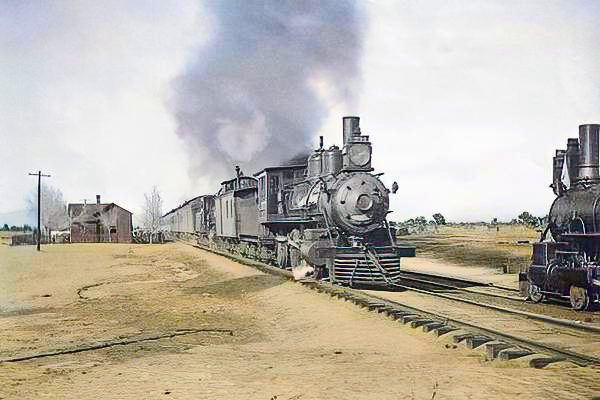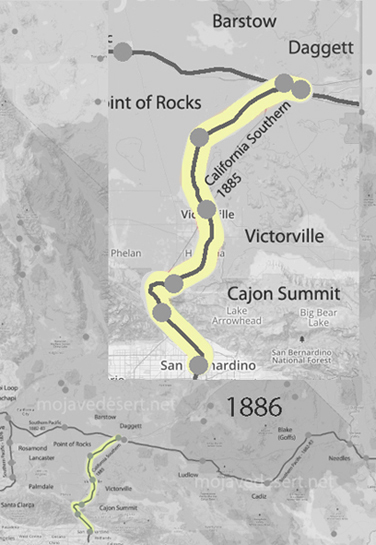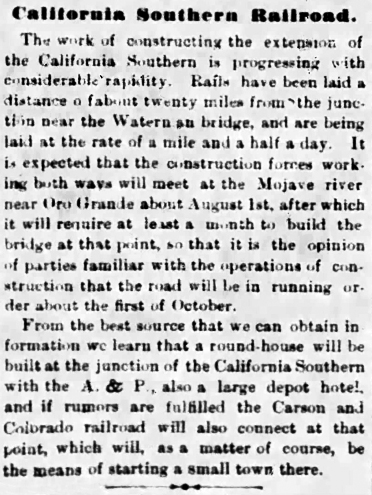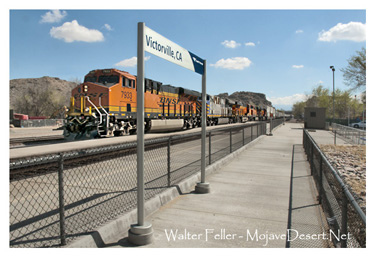California Southern Railway

California Southern Railway was a historical railroad company that operated in Southern California in the late 19th and early 20th centuries. It played a significant role in the development of the region, connecting various cities and contributing to the growth of industries such as agriculture, mining, and tourism.
The California Southern Railway was incorporated in 1880 to build a rail line from National City (near San Diego) to Barstow, California. The company faced numerous challenges during construction, including difficult terrain, limited resources, and financial difficulties. However, it persevered and completed the first rail line section connecting National City to San Bernardino in 1883.

With this initial success, the California Southern Railway continued to expand its network, reaching Colton in 1884 and Barstow in 1885. The completion of the rail line provided a vital transportation link between Southern California and the rest of the country. It facilitated the movement of goods, people, and ideas, contributing to the economic and cultural development of the region.
The California Southern Railway also played a crucial role in city growth along its route. It spurred the establishment of new towns and communities and their expansion. The railway provided trade, commerce, and employment opportunities, attracting settlers and businesses to the area.
In addition to its economic impact, the California Southern Railway also significantly influenced tourism in Southern California. The rail line connected to popular destinations such as San Diego, Santa Ana, and Riverside, making it easier for tourists to visit these areas. The railway actively promoted tourism, advertising the region's natural beauty, pleasant climate, and recreational opportunities.
However, despite its initial success, the California Southern Railway faced financial difficulties in the late 1880s. It was acquired by the Atchison, Topeka, and Santa Fe Railway in 1905. Santa Fe continued to operate and expand the rail line, incorporating it into its larger network.
Today, the California Southern Railway legacy can still be seen in Southern California. Many of the towns and cities along its former route continue to thrive, and some of the original railway structures have been preserved as historical landmarks. The railway's impact on the region's development and transportation history remains significant, reminding us of the importance of railroads in shaping the growth of California.
-wf
The work of constructing the extension of the California Southern is progressing with considerable rapidity. Rails have been laid at a distance of about twenty miles from junction near the Waterman bridge, and are being laid at the rate of a mile and a half a day. It is expected that the construction forces working both ways will meet at the Mojave River near Oro Grande about August 1st., after which they will it will require at least a month to build the bridge at that point, so that it is the opinion of parties familiar with the operations of construction that the road will be in running order about the first of October.
From the best source that we can obtain information we learn that a round-house will be built at the junction of the California Southern with the A&P, also a large depot hotel, and if rumors are fulfilled the Carson and Colorado railroad will also connect at that point, which will, as a matter of course, be the means of starting a small town there.
~ Calico Print Sun. 19 July 1885

Building California Southern in Cajon Pass
The California Southern Railroad was a "subsidiary" of the Santa Fe Railroad that served between Barstow, CA and National City, CA. The line was completed in November, 1885 and became the western terminus of Santa Fe's line to Chicago. Two critical parts were troublesome; one between Oceanside and Temecula and another between Elsinore (Lake Elsinore today) and Perris. These canyon segments faced washouts from typically dry rivers in narrow canyon passes. Segments of the line still exist from Perris to Barstow and from Camp Pendleton (just north of Oceanside) down to National City.
SDERA / National City Depot Museum
The Fallbrook Line
Perris and its Railroad
(Excerpts/Notes) Perris and its Railroadby Richard V. Dodge
Printed in DISPATCHER November 15, 1959 Issue 29
Fred T. Perris, who was in charge of the surveying, and his party were withdrawn from the line location in Cajon Pass and set to work on the Box Springs route. Riverside residents bemoaned "Mr. Nickerson (of the Santa Fe)wags the dog, head and tail, and locates the road three miles out on the barren plain (through Highgrove).
The Atchison, Topeka & Santa Fe Railroad, controlled by Boston capitalists, was headed west. Its rails had reached Albuquerque, New Mexico, in 1880. It was being extended south towards El Paso. The company had formed a partnership with the St. Louis & San Francisco Railway to build the Atlantic & Pacific Railroad on the authorized 35th parallel of latitude route from a junction at the present town of Isleta west to the Colorado River and into California.
Subsidies offered by the towns of National City and San Diego to make San Diego Bay the "Pacific Coast Terminus of the Santa Fe Route" were accepted. The California Southern Rail Road was organized in 1880 to build from National City in a generally northeasterly direction to the town of San Bernardino and on to a connection with the Atlantic & Pacific in California.
In November, J. 0. Osgood resigned as Chief Engineer and Fred Perris was appointed to the position in the following year. After completing the road to San Bernardino on September 13, 1883, Perris again turned his attention to the task of conquering Cajon Pass.
Fred T. Perris was born in England about the year 1836. His family first moved to Australia and Fred came to the United States in 1852. He worked on the Union Pacific Railroad in the 60's, then settled in San Bernardino in 1874. He was chosen as a delegate in 1880 to the conference with Boston capitalists on the proposed building of the California Southern Railroad. He invited attention to the attractions of the San Bernardino area.
He surveyed all the lines in the Southern California network and equipped the shops.
. . .
Construction progressed on the line between San Bernardino and Barstow. The last spike was driven in the pass on November 9, 1885, joining the California Southern with the Atlantic & Pacific and all points east. Incidentally the Atlantic & Pacific operated over the Southern Pacific track, under a deferred purchase agreement, between The Needles and Mojave, through Barstow.
Mother Nature dealt another staggering blow in February 1891. "All railroads are washed out." About five miles of track in Cajon Pass were destroyed.
In June 1904 the Southern California Railway was leased to The Atchison, Topeka & Santa Fe Railway and complete acquisition of the former was effected in January 1906.

California Southern
The California Southern finds a northerly course from the San Diego County line through this county to its junction with the Atlantic & Pacific at Barstow. It lacks one-fourth of a mile of having 100 miles of main track. In round numbers, a valuation of $522,000 is placed upon its rights and property. This road, with the California Central, is operated by the California Southern Railway Company. The machine shops, etc., of the Sante Fe line at San Bernardino were erected at a cost of $50,000, with stock and machinery, and the company pays out to its employes here the sum of $40,000, all of which goes into circulation in this section.
pg427 illustrated History of socal Lewis 1890

Calico Print 19 July 1885
Barstow is situated at the junction of the California Southern and the A. &. P. Railway, eighty-two miles from San Bernardino and twelve miles from Daggett. It has an elevation of 1,900 feet. The population is about 300. The town is comparatively new. The climate is dry and clear with no fogs or dampness. There is a postoffice, telegraph, telephone and express offices, and daily stage for Calico, connecting with trains, as well as several stores carrying general merchandise, and a large railroad hotel. A silver mine and mill are to be found just north of this place.
History of Southern California - 1890 Lewis Publishing
Jacob Nash Victor
Atlantic & Pacific RR
Cajon Pass History
